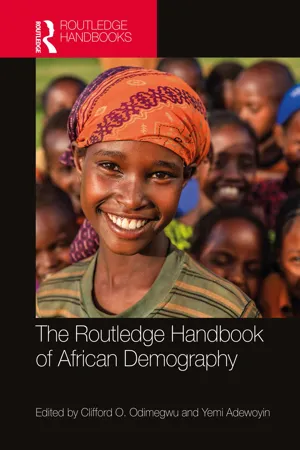
The Routledge Handbook of African Demography
- 888 pages
- English
- ePUB (mobile friendly)
- Available on iOS & Android
The Routledge Handbook of African Demography
About This Book
This handbook provides an authoritative and comprehensive overview of African population dynamics, variations, causes and consequences, demonstrating the real-world applications of research in policies and programmes.African demography has come of age. Over 50 years, the discipline has grown exponentially in the number of training and research institutions, specialist experts and academic output, all with an aim of addressing the enormous demographic challenges faced by the continent. The book draws on old and emerging analytical tools to explore the relationships between population dynamics and social, economic, cultural and political environments from African perspectives. Key topics include fertility, sexual behaviours, healthcare, ageing, mortality, migration, displacement, the causes and consequences of demographic changes and teaching and research developments in African demography. The Routledge Handbook of African Demography will be an essential resource for students and researchers of African demography, sociology, development and cultural studies.
Frequently asked questions
Information
PART 1 Introductory chapters
1 INTRODUCTION
Introduction
Table of contents
- Cover Page
- Half Title Page
- Title Page
- Copyright Page
- Dedication Page
- Table of Contents Page
- List of Figures Page
- List of Tables Page
- List of Contributors Page
- Foreword Page
- Preface Page
- Acknowledgements Page
- PART 1 Introductory chapters
- PART 2 Demographic training and research
- PART 3 Marriage, fertility and SRH
- PART 4 Gender in African demography
- PART 5 Environment, health and demography
- PART 6 Migration
- PART 7 Demographic dividend
- PART 8 Ageing
- PART 9 Mortality
- PART 10 Concluding matters
- Index